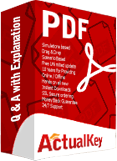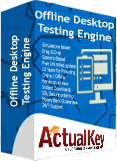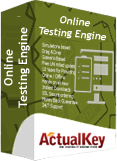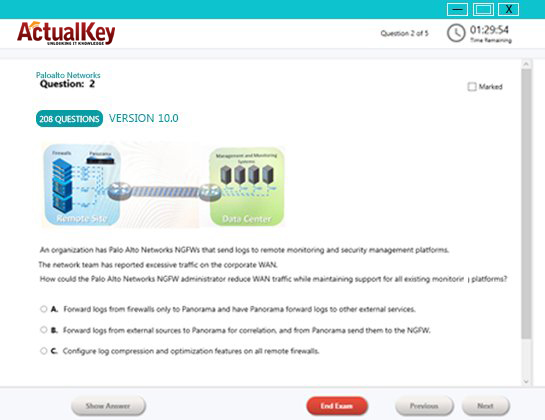Limited Time 30% Discount Offer Use Code - off30
Actualkey Prepration Latest 400-351 : CCIE Wireless R&S Lab Exam Questions and Answers PDF's, Verified Answers via Experts - Pass Your Exam For Sure and instant Downloads - "Money Back Guarantee".
| Vendor | Cisco |
| Certification | CCIE Wireless |
| Exam Code | 400-351 |
| Title | CCIE Wireless R&S Lab Exam |
| No Of Questions | 434 |
| Last Updated | September 16,2024 |
| Product Type | Q & A with Explanation |
| Bundel Pack Included | PDF + Offline / Andriod Testing Engine and Simulator |
400-351 CCIE Wireless
Exam Number 400-351
Associated Certifications CCIE Wireless
Duration 120 minutes (90-110 questions)
Available Languages English
The Cisco CCIE Wireless Written Exam is a 2-hour test that will validate that a wireless engineer has the expertise to plan, design, implement, operate, and troubleshoot complex enterprise WLAN networks.
Review exam topics v3.0 (Recommended for candidates scheduled to take the exam before November 8, 2017)
Review exam topics v3.1 (Recommended for candidates scheduled to take the exam on November 8, 2017 and beyond)
Exam Description
The Cisco CCIE® Wireless Version 3.1 exam unifies written and lab exam topics documents into a unique curriculum, while explicitly disclosing which domains pertain to which exam, and the relative weight of each domain.
The Cisco CCIE® Wireless Written Exam (400-351) is a two-hour test with 90−110 questions that assesses and validates wireless expertise at the highest level. Candidates who pass the CCIE Wireless written exam demonstrate broad theoretical knowledge of wireless networking at enterprise level, including a solid understanding of wireless local area networking (WLAN) technologies, and the ability to design, implement, and troubleshoot complex wireless solutions. The exam is closed book and no outside reference materials are allowed.
An Evolving Technologies section is included in the Written exam only. It will enable candidates to bridge their core technology expertise with knowledge of the evolving technologies that are being adopted at an accelerated pace, such as Cloud, Network Programmability, and IoT.
The Cisco CCIE® Wireless Lab Exam is an eight-hour, hands-on exam which requires candidates to configure, diagnose, and troubleshoot a series of complex network scenarios. The candidate will need to understand how the network and service components interoperate, and how the functional requirements translate into specific device configurations. Knowledge of troubleshooting is an important skill and candidates are expected to diagnose and solve issues as part of the CCIE lab exam. The candidate will not configure all end-user systems; however, the candidate will be responsible for all devices residing in the network.
The following topics are general guidelines for the content likely to be included on the exam. However, other related topics may also appear on any specific delivery of the exam. In order to better reflect the contents of the exam and for clarity purposes, the guidelines below may change at any time without notice.
1.0 Plan and Design WLAN Technologies 16%
1.1 Describe WLAN organizations and regulations
1.2 Describe IEEE 802.11 standards and protocols
1.3 Plan & design wireless solutions requirements
1.3.a Translate customer requirements into services and design recommendations
1.3.b Identify ambiguity and/or information gaps
1.3.c Evaluate interoperability of proposed technologies against deployed IP network infrastructure & technologies
1.3.d Select an appropriate deployment model
1.3.e Regulatory domains and country codes
1.4 RF planning, designing and validation
1.4.a RF Design / Site survey
1.4.a [i] Define the tasks/goals for a preliminary site survey
1.4.a [ii] Conduct the site survey
1.4.a [iii] Determine AP quantity, placement and antenna type
1.4.b Architect indoor and outdoor RF deployments
1.4.b [i] Coverage
1.4.b [ii] Throughput
1.4.b [iii]Voice
1.4.b [iv]Location
1.4.b [v] High Density / Very High Density
1.4.c Construct an RF operational model that includes:
1.4.c [i] Radio resource management (Auto-RF, manual, hybrid, Flexible Radio Assignment, TPC and DCA)
1.4.c [ii] Channel use (radar, non-WiFi interference, Dynamic Bandwidth Selection)
1.4.c [iii] Power level, overlap
1.4.c [iv] RF profiles
1.4.d Validate implemented RF deployment
2.0 Configure and Troubleshoot the Network Infrastructure 12%
2.1 Configure and troubleshoot wired infrastructure to support WLANs
2.1.a VLANs
2.1.b VTP
2.1.c STP
2.1.d Etherchannel
2.2 Plan network infrastructure capacity
2.3 Configure and troubleshoot network connectivity for:
2.3.a WLAN clients
2.3.b WLCs (appliance, virtual, and Mobility Express)
2.3.c Lightweight APs
2.3.d Autonomous APs
2.4 Configure and troubleshoot PoE for APs
2.5 Configure and troubleshoot QoS on the switching infrastructure
2.5.a MQC
2.5.b MLS QoS
2.6 Configure and troubleshoot multicast on the switching infrastructure
2.6.a PIM
2.6.b Basic IGMP (including IGMP snooping)
2.6.c MLD
2.7 Configure and troubleshoot IPv4 connectivity
2.7.a Subnetting
2.7.b Static and inter-VLAN routing
2.8 Configure and troubleshoot basic IPv6 connectivity
2.8.a Subnetting
2.8.b Static and inter-VLAN routing
2.9 Configure and troubleshoot wired security for APs
2.9.a MAB
2.9.b dot1X for APs
2.10 Configure and troubleshoot the following to support wireless services
2.10.a DNS
2.10.b DHCPv4 / DHCPv6
2.10.c NTP, SNTP
2.10.d SYSLOG
2.10.e SNMP
2.10.f CDP, LLDP
2.10.g mDNS (including SDG)
3.0 Configure and Troubleshoot an Autonomous Deployment Model 8%
3.1 Configure and troubleshoot different modes and roles
3.1.a WGB
3.1.b Point to point & Point to multi-point bridge
3.2 Configure and troubleshoot SSID/MBSSID
3.3 Configure and troubleshoot security
3.3.a L2 security policies
3.3.b Association filters
3.3.c Local radius
3.3.d dot1X profiles
3.4 Configure and troubleshoot radio settings
3.5 Configure and troubleshoot multicast
3.6 Configure and troubleshoot QoS
4.0 Configure and Troubleshoot AireOS appliance, virtual, and Mobility Express controllers 18%
4.1 Configure and troubleshoot secure management access and control plane
4.1.a AAA
4.1.b CPU ACLs
4.1.c Management via wireless interface
4.1.d Management via dynamic interface
4.2 Configure and troubleshoot interfaces
4.3 Configure and troubleshoot lightweight APs
4.3.a dot1x
4.3.b AP modes
4.3.c AP authentication / AP authorization
4.3.d Logging
4.3.e Local AP CLI configuration
4.3.f WLC based AP configuration
4.4 Configure and troubleshoot high availability and redundancy
4.4.a SSO
4.4.b N+1, N+N
4.5 Configure and troubleshoot wireless segmentation
4.5.a RF profiles
4.5.b AP groups
4.5.c FlexConnect
4.6 Configure and troubleshoot wireless security policies
4.6.a WLANs
4.6.b L2/L3 security
4.6.c Rogue policies
4.6.d Local EAP
4.6.e Local profiling
4.6.f ACLs
4.6.g Certificates
4.7 Configure and troubleshoot FlexConnect and Office Extend
4.8 Configure and troubleshoot Mesh
4.9 Implement RF management
4.9.a Static RF management
4.9.b Automatic RF management
4.9.c CleanAir
4.9.d Data rates
4.9.e RX-SOP
4.9.f Air Time Fairness (ATF)
4.9.g Flexible Radio Assignment (FRA)
4.10 Configure and troubleshoot mobility
4.10.a L2/L3 roaming
4.10.b Multicast optimization
4.10.c Mobility group scaling
4.10.d Inter-release controller mobility
4.10.e Mobility anchoring
4.11 Configure and troubleshoot multicast
4.12 Configure and troubleshoot client roaming optimization
4.12.a CCKM
4.12.b Optimized Roaming
4.12.c Band Select
4.12.d Load Balancing
4.12.e 802.11r/k/v
5.0 Configure and Troubleshoot Wireless Security & Identity Management with ISE 13%
5.1 Configure and troubleshoot identity management
5.1.a Basic PKI for dot1x and WebAuth
5.1.b External identity sources (AD)
5.2 Configure and troubleshoot AAA policies
5.2.a Client authentication and authorization
5.2.b Management authentication and authorization
5.2.c Client profiling and provisioning
5.2.d RADIUS attributes
5.2.e CoA
5.3 Configure and troubleshoot wireless guest management
5.3.a Local web authentication
5.3.b Central web authentication
5.3.c Basic sponsor policy
6.0 Configure and Troubleshoot Prime Infrastructure and MSE/CMX 12%
6.1 Configure and troubleshoot management access
6.1.a AAA
6.1.b Virtual domain
6.2 Perform basic operations
6.2.a Create and deploy templates
6.2.b Operate maps
6.2.c Import infrastructure devices
6.2.d High availability
6.2.e Audits
6.2.f Client troubleshooting
6.2.g Notification receivers
6.2.h Reports
6.2.i Monitoring policies
6.3 Configure and troubleshoot Prime Infrastructure jobs
6.4 Operate Security management
6.4.a Configure rogue management
6.4.b Manage alarms and events
6.5 Implement and troubleshoot MSE/CMX
6.5.a Management access
6.5.b Network services
6.5.b [i] Location
6.5.b [ii] Analytics
6.5.b [iii] Connect and Engage
6.5.b [iv] CleanAir
6.5.b [v] wIPS
6.5.c NMSP
6.6 Integrate ISE with Prime Infrastructure and MSE/CMX
7.0 Configure and Troubleshoot WLAN media and application services 11%
7.1 Configure and troubleshoot voice over wireless
7.1.a QoS profiles
7.1.b EDCA
7.1.c WMM
7.1.d BDRL
7.1.e Admission control
7.1.f MQC/MLS
7.2 Configure and troubleshoot video and media
7.2.a Media Stream
7.2.b Admission control
7.3 Configure and troubleshoot mDNS
7.3.a mDNS proxy
7.3.b Service discovery
7.3.c Service filtering
7.4 Configure and troubleshoot AVC and netflow
7.5 Configure and troubleshoot FastLane and Adaptive Fast Transition (802.11r)
8.0 Evolving Technologies 10%
8.1 Cloud
8.1.a Compare and contrast Cloud deployments models
8.1.a [i] Infrastructure, platform, and software services (XaaS)
8.1.a [ii] Performance and reliability
8.1.a [iii] Security and privacy
8.1.a [iv] Scalability and interoperability
8.1.b Describe Cloud implementations and operations
8.1.b [i] Automation and orchestration
8.1.b [ii] Workload mobility
8.1.b [iii] Troubleshooting and management
8.1.b [iv] OpenStack components
8.2 Network programmability [SDN]
8.2.a Describe functional elements of network programmability (SDN) and how they interact
8.2.a [i] Controllers
8.2.a [ii] APIs
8.2.a [iii] Scripting
8.2.a [iv] Agents
8.2.a [v] Northbound vs. Southbound protocols
8.2.b Describe aspects of virtualization and automation in network environments
8.2.b [i] DevOps methodologies, tools and workflows
8.2.b [ii] Network/application function virtualization (NFV, AFV)
8.2.b [iii] Service function chaining
8.2.b [iv] Performance, availability, and scaling considerations
8.3 Internet of Things
8.3.a Describe architectural framework and deployment considerations formInternet of Things (IoT)
8.3.a [i] Performance, reliability and scalability
8.3.a [ii] Mobility
8.3.a [iii] Security and privacy
8.3.a [iv] Standards and compliance
8.3.a [v] Migration
8.3.a [vi] Environmental impacts on the network
CCIE Wireless Written Exam (400-351)
Exam Description
The Cisco CCIE® Wireless Written Exam (400-351) is a two-hour test with 90−110 questions that assesses and validates wireless expertise at the highest level. Candidates who pass the CCIE Wireless written exam demonstrate broad theoretical knowledge of wireless networking at enterprise level, including a solid understanding of wireless local area networking (WLAN) technologies, and the ability to design, implement, and troubleshoot complex wireless solutions.
An Evolving Technologies section is included in the Written exam only. It will enable candidates to bridge their core technology expertise with knowledge of the evolving technologies that are being adopted at an accelerated pace, such as Cloud, Network Programmability and IoT.
The exam is closed book and no outside reference materials are allowed. The following topics are general guidelines for the content that is likely to be included on the lab exam. However, other related topics may also appear on any specific delivery of the exam. In order to better reflect the contents of the exam and for clarity purposes, the following guidelines may change at any time without notice.
1.0 Planning & Designing WLAN Technologies 11%
1.1 Describe WLAN organizations and regulations
1.2 Describe IEEE 802.11 standards and protocols
1.3 Plan & design wireless solutions requirements
1.3.a Translate customer requirements into services and design recommendations
1.3.b Identify ambiguity and/or information gaps
1.3.c Evaluate interoperability of proposed technologies against deployed IP network infrastructure & technologies
1.3.d Select an appropriate deployment model
1.3.e Regulatory domains and country codes
1.4 RF planning, designing and validation
1.4.a RF Design / Site survey
1.4.a [i] Define the tasks/goals for a preliminary site survey
1.4.a [ii] Conduct the site survey
1.4.a [iii] Determine AP quantity, placement and antenna type
1.4.b Architect indoor and outdoor RF deployments
1.4.b [i] Coverage
1.4.b [ii] Throughput
1.4.b [iii] Voice
1.4.b [iv] Location
1.4.b [v] HD
1.4.c Construct an RF operational model that includes:
1.4.c [i] Radio resource management (Auto-RF, manual, hybrid, TPC and DCA)
1.4.c [ii] Channel use (radar, non-WiFi interference)
1.4.c [iii] Power level, overlap
1.4.c [iv] RF profiles
1.4.d Validate implemented RF deployment
2.0 Configure and Troubleshoot the Network Infrastructure 10%
2.1 Configure and troubleshoot wired infrastructure to support WLANs
2.1.a VLANs
2.1.b VTP
2.1.c STP
2.1.d Etherchannel
2.1.e HSRP
2.1.f VSS
2.1.g Stacking
2.2 Plan network infrastructure capacity
2.3 Configure and troubleshoot network connectivity for:
2.3.a WLAN clients
2.3.b WLCs
2.3.c Lightweight APs
2.3.d Autonomous APs
2.4 Configure and troubleshoot PoE for APs
2.5 Configure and troubleshoot QoS on the switching infrastructure
2.5.a MQC
2.5.b Mls qos
2.6 Configure and troubleshoot multicast on the switching infrastructure
2.6.a PIM-SM
2.6.b Auto-RP
2.6.c Static-RP
2.6.d IGMP
2.6.e IGMP snooping
2.6.f MLD
2.7 Configure and troubleshoot IPv4 connectivity
2.7.a Subnetting
2.7.b Static routing
2.7.c Basic OSPF
2.7.d Basic EIGRP
2.8 Configure and troubleshoot basic IPv6 connectivity
2.8.a Subnetting
2.8.b Static routing
2.8.c Basic OSPFv3
2.8.d Basic EIGRP address families
2.9 Configure and troubleshoot wired security
2.9.a ACLs (v4/v6)
2.9.b dot1X
2.9.c Port-security
2.9.d SXP, SGT
2.10 Configure and troubleshoot network services
2.10.a DNS
2.10.b DHCPv4 / DHCPv6
2.10.c NTP, SNTP
2.10.d SYSLOG
2.10.e SNMP
2.10.f CDP, LLDP
2.10.g SDG. mDNS
3.0 Configure and Troubleshoot an Autonomous Deployment Model 10%
3.1 Configuring and troubleshooting different modes and roles
3.1.a Root
3.1.b WGB
3.1.c Bridge
3.2 Configuring and troubleshooting SSID/MBSSID
3.3 Configuring and troubleshooting security
3.3.a L2 security policies
3.3.b Association filters
3.3.c PSPF
3.3.d Local radius
3.3.e dot1x profiles
3.3.f Guest
3.4 Configuring and troubleshooting radio settings
3.5 Configuring and troubleshooting multicast
3.6 Configuring and troubleshooting QoS
4.0 Configure and Troubleshoot a Unified Deployment Model (Centralized) 18%
4.1 Configuring and controlling management access
4.2 Configuring and troubleshooting interfaces
4.3 Configuring and troubleshooting lightweight APs
4.3.a dot1x
4.3.b LSC
4.3.c AP modes
4.3.d AP authentication / authorization
4.3.e Logging
4.3.f Local / global configuration
4.4 Configuring and troubleshooting high availability and redundancy
4.4.a Clients
4.4.b APs
4.4.c WLCs
4.5 Configuring and troubleshooting wireless segmentation
4.5.a RF profiles
4.5.b AP groups
4.5.c Flexconnect
4.6 Configuring and troubleshooting wireless security policies
4.6.a WLANs
4.6.b L2/L3 security
4.6.c Rogue policies
4.6.d Local EAP
4.6.e Local profiling
4.6.f ACLs
4.6.g Certificates
4.7 Configuring and troubleshooting Flexconnect and Office Extend
4.8 Configuring and troubleshooting Mesh
4.9 Implement RF management
4.9.a Static RF management
4.9.b Automatic RF management
4.9.c CleanAir
4.9.d Data rates
4.10 Configuring and troubleshooting WLC control plane security
4.10.a AAA
4.10.b CPU ACLs
4.10.c Management via wireless interface
4.10.d Management via dynamic interface
4.11 Configuring and troubleshooting mobility
4.11.a L2/L3 roaming
4.11.b Multicast optimization
4.11.c Mobility group scaling
4.11.d Inter-release controller mobility
4.11.e New mobility
4.11.f Mobility anchoring
4.12 Configuring and troubleshooting multicast
5.0 Configure and Troubleshoot a Unified Deployment Model (Converged) 11%
5.1 Configuring and controlling management access
5.2 Configuring and troubleshooting Interfaces
5.3 Configuring and troubleshooting lightweight APs
5.3.a dot1x
5.3.b AP authentication / authorization
5.3.c Logging
5.3.d Local / global configuration
5.4 Configuring and troubleshooting high availability and redundancy
5.4.a Clients
5.4.b APs
5.4.c WLCs
5.5 Configuring and troubleshooting wireless segmentation
5.5.a RF profiles
5.5.b AP groups
5.6 Configuring and Troubleshooting wireless security policies
5.6.a WLANs
5.6.b L2/L3 security
5.6.c Rogue policies
5.6.d Local EAP
5.6.e ACLs
5.6.f Certificates
5.7 Implement RF management
5.7.a Static RF management
5.7.b Automatic RF management
5.7.c CleanAir
5.7.d Data rates
5.8 Configuring and troubleshooting WLC control plane security
5.8.a AAA
5.8.b Basic control plane policing
5.9 Configuring and troubleshooting mobility
5.9.a L2/L3 roaming
5.9.b Multicast optimization
5.9.c Mobility group scaling
5.9.d Inter-release controller mobility
5.9.e Mobility anchoring
5.9.f SPG
5.9.g MC/MA
5.10 Configuring and troubleshooting multicast
6.0 Configure and Troubleshoot Security & Identity Management 10%
6.1 Configure and troubleshoot identity management
6.1.a Basic PKI for dot1x and webauth
6.1.b External identity sources (AD, LDAP)
6.2 Configure and troubleshoot AAA policies
6.2.a Client authentication and authorization
6.2.b Management authentication and authorization
6.2.c Client profiling and provisioning
6.2.d RADIUS attributes
6.2.e CoA
6.3 Configure and troubleshoot guest management
6.3.a Local web authentication
6.3.b Central web authentication
6.3.c Basic sponsor policy
7.0 Configure and Troubleshoot Prime Infrastructure and MSE 10%
7.1 Configure and troubleshoot management access
7.1.a AAA
7.1.b Virtual domain
7.2 Perform basic operations
7.2.a Create and deploy templates
7.2.b Operate maps
7.2.c Import infrastructure devices
7.2.d High availability
7.2.e Audits
7.2.f Client troubleshooting
7.2.g Notification receivers
7.2.h Reports
7.3 Perform maintenance operations
7.3.a Background tasks
7.3.b SW image management
7.4 Security management
7.4.a Understand rogue management
7.4.b Manage alarms and events
7.4.c Understand security index
7.5 Implement and troubleshoot MSE
7.5.a Management access
7.5.b Network services
7.5.b [i] Location
7.5.b [ii] CMX
7.5.b [iii] CleanAir
7.5.b [iv] WIPS
7.5.c NMSP
7.6 Integrate ISE
7.7 Integrate netflow
8.0 Configure and Troubleshoot WLAN media and application services 10%
8.1 Configure and troubleshoot voice over wireless
8.1.a QoS profiles
8.1.b EDCA
8.1.c WMM
8.1.d BDRL
8.1.e Admission control
8.1.f MQC
8.2 Configuring and troubleshooting video and media
8.2.a Mediastream
8.2.b Multicast-direct
8.2.c Admission control
8.3 Configuring and troubleshooting mDNS
8.3.a mDNS proxy
8.3.b Service discovery
8.3.c Service filtering
8.4 Configuring and troubleshooting AVC and netflow
9.0 Evolving Technologies 10%
9.1 Cloud
9.1.a Compare and contrast Cloud deployment models
9.1.a [i] Infrastructure, platform, and software services (XaaS)
9.1.a [ii] Performance and reliability
9.1.a [iii] Security and privacy
9.1.a [iv] Scalability and interoperability
9.1.b Describe Cloud implementations and operations
9.1.b [i] Automation and orchestration
9.1.b [ii] Workload mobility
9.1.b [iii] Troubleshooting and management
9.1.b [iv] OpenStack components
9.2 Network programmability [SDN]
9.2.a Describe functional elements of network programmability (SDN) and how they interact
9.2.a [i] Controllers
9.2.a [ii] APIs
9.2.a [iii] Scripting
9.2.a [iv] Agents
9.2.a [v] Northbound vs. Southbound protocols
9.2.b Describe aspects of virtualization and automation in network environments
9.2.b [i] DevOps methodologies, tools and workflows
9.2.b [ii] Network/application function virtualization (NFV, AFV)
9.2.b [iii] Service function chaining
9.2.b [iv] Performance, availability, and scaling considerations
9.3 Internet of Things
9.3.a Describe architectural framework and deployment considerations for Internet of Things (IoT)
9.3.a [i] Performance, reliability and scalability
9.3.a [ii] Mobility
9.3.a [iii] Security and privacy
9.3.a [iv] Standards and compliance
9.3.a [v] Migration
9.3.a [vi] Environmental impacts on the network
I Got My Success Due To Actualkey 400-351 Bundle Pack Actualkey experts I got passed in the 400-351 exam without any worries at all, these exam material products gave me the reason to relax.
Budi Saptarmat
Yahoo! Got Successfully Through The 400-351 Exam Passing Exam is not a easy thanks to Acutalkey.com for providing me actual 400-351 CCIE Wireless R&S Lab Exam training with there included the Offline and Android simulators helps me success
Melinda
400-351 Exam Best Preparation I have been preparing for 400-351 CCIE Wireless R&S Lab Exam, I was not sure that I'll be able to pass because of the fact that I am not a good student however;Actualkey.com provided me best and simple exam training pdf's and I passed. I now recommend everyone
Antonio Moreno
Actualkey.com 400-351 Offline Simulator is Best My choice to select Actualkey.com and go for the preparation 400-351 CCIE Wireless R&S Lab Exam, because I got the short way with the easy way
Liliane Meichner
Actualkey.com 400-351 Exam PDF"s passed with in a week 400-351 exam pdf's that's amazing
James Wilson
Cisco - RELATED EXAMS
Implementing Cisco Unified Communications Manager Part 2 (CIPT2 v6.0)
Questions: 174 | May 8, 2024
Implementing Cisco Security Monitoring, Analysis andResponse System
Questions: 49 | May 8, 2024
Cisco Wide Area Application Services for System Engineers exam
Questions: 60 | August 1, 2024
Cisco Data Center Networking Infrastructure Solutions design
Questions: 120 | August 1, 2024
Implementing Cisco Unified Wireless Networking Essentials (IUWNE)
Questions: 203 | July 1, 2024
Associated Certifications: Cisco Storage Networking Support Specialist
Questions: 74 | August 1, 2024
Implementing Cisco Security Monitoring, Analysis, and Response System
Questions: 67 | August 1, 2024
Wide Area Application Services for System Engineers (WAASSE)
Questions: 90 | January 5, 2024
Implementing Advanced Cisco Unified Wireless Security (IAUWS)
Questions: 85 | January 7, 2024
Troubleshooting and Maintaining Cisco IP Switched Networks (TSHOOT)
Questions: 72 | January 7, 2024
Implementing Cisco Unified Communications Voice over IP and QoS v8.0 (CVOICE v8.0)
Questions: 257 | July 1, 2024
Securing Networks with Cisco Routers and Switches (SECURE) v1.0
Questions: 136 | July 1, 2024
Implementing Cisco Unified CommunicationsManager, Part 2 v8.0 (CIPT2 v8.0)
Questions: 215 | July 1, 2024
Introducing Cisco Voice and Unified Communications Administration v8.0
Questions: 300 | May 8, 2024
Integrating Cisco Unified Communications Applications v8.0 (CAPPS v8.0)
Questions: 203 | May 8, 2024
Operational Foundations for Cisco Service Provider Core Networks
Questions: 91 | May 8, 2024
Maintaining Cisco Service Provider VPNs and MPLS Networks (MSPVM)
Questions: 89 | May 8, 2024
Cisco Data Center Unified Computing Support Specialist Qualifier Exam (DCUCI Qualifier Exam)
Questions: 65 | May 8, 2024
Cisco Data Center Unified Computing Design Specialist Qualifier Exam
Questions: 62 | May 8, 2024
Designing for Cisco Internetwork Solutions Exam (DESGN) v2.1
Questions: 241 | October 1, 2024
Maintaining Cisco Service Provider Routing Protocols (MSPRP)
Questions: 70 | October 1, 2024
Maintaining Cisco Service Provider Quality of Service (MSPQS)
Questions: 91 | October 1, 2024
PSACAS Advanced Collaboration Architecture Sales Specialist Exam
Questions: 56 | May 8, 2024
PSACASE Advanced Collaboration Architecture System Engineer Exam
Questions: 64 | May 8, 2024
PSACAFE Advanced Collaboration Architecture Field Engineer Exam
Questions: 50 | August 1, 2024
Cisco IronPort Certified Security Professional (CICSP) Web Security 7.0
Questions: 66 | August 1, 2024
Implementing Cisco TelePresence Video Networking Solutions Exam
Questions: 57 | August 1, 2024
Advanced Borderless Network Architecture Systems Engineer Exam
Questions: 60 | August 1, 2024
Cisco Substation Automation System and Field Engineer Knowledge Verification
Questions: 58 | May 8, 2024
Authorized Connected Grid Account Manager Knowledge Verification
Questions: 23 | August 1, 2024
Cisco Data Center Unified Computing Systems Implementation (DCUCI)
Questions: 78 | May 8, 2024
Introduction to 802.1X Operations for Cisco Security Professionals Exam (S802DT1X)
Questions: 69 | May 8, 2024
Introducing Cisco Identity Services Engine for System Engineer Exam (PAISESE)
Questions: 34 | May 8, 2024
PASCERAM - Cisco SaaS Conferencing and EIM Resale ATP for the AM Exam
Questions: 35 | May 8, 2024
Cisco SP Video Wireline & Cable Headend Design Specialist for SE
Questions: 33 | May 8, 2024
PASCERSE - Cisco SaaS Conferencing and EIM Resale ATP for the SE Exam
Questions: 56 | May 8, 2024
Building Cisco Service Provider Next-Generation Networks, Part 2
Questions: 126 | May 8, 2024
Building Cisco Service Provider Next-Generation Networks, Part 1 Exam
Questions: 257 | October 25, 2024
Implementing Advanced Cisco Unified Wireless Security (IAUWS) v2.0
Questions: 206 | May 8, 2024
Deploying Cisco Service Provider Network Routing (SPROUTE)
Questions: 174 | January 12, 2024
Implementing Cisco Service Provider Next-Generation Core Network Services (SPCORE)
Questions: 184 | January 12, 2024
Implementing Cisco Service Provider Next-Generation Edge Network Services (SPEDGE) Exam
Questions: 185 | January 12, 2024
Implementing and Maintaining Cisco Technologies Using IOS XR - (IMTXR)
Questions: 77 | January 12, 2024
Designing and Implementing Cisco Unified Communications on Unified Computing Systems - DIUCUCS
Questions: 60 | January 12, 2024
Implementing and Configuring Cisco Identity Service Engine - SISE
Questions: 49 | July 1, 2024
PASCERFE - Cisco SaaS Conferencing and EIM Resale ATP for the FE Exam
Questions: 53 | July 1, 2024
Advanced Borderless Network Architecture Field Engineer Exam
Questions: 86 | January 15, 2024
Advanced Borderless Network Architecture Systems Engineer Exam (700-303)
Questions: 156 | January 15, 2024
Cisco Implementing Cisco Secure Mobility Solutions Exam (SIMOS)
Questions: 543 | May 17, 2024
Unified Communications Contact Center Express Implementation - UCCX
Questions: 50 | January 15, 2024
Performing Business-Focused Transformative Architecture Engagements
Questions: 67 | January 17, 2024
Configuring Cisco UCS and Cisco Catalyst 3000 for Vblock Series 100
Questions: 45 | January 17, 2024
Cisco Application Centric Infrastructure for System Engineers
Questions: 58 | January 17, 2024
Implementing Cisco Service Provider Mobile Unlicensed Small Cell Solutions
Questions: 51 | January 17, 2024
Securing Cisco Networks with Sourcefire Intrusion Prevention System
Questions: 59 | January 17, 2024
Implementing Cisco Service Provider Mobility UMTS Networks (SPUMTS)
Questions: 70 | January 17, 2024
Implementing Cisco Service Provider Mobility CDMA Networks (SPCDMA)
Questions: 70 | January 17, 2024
Implementing Cisco Service Provider Mobility LTE Networks (SPLTE)
Questions: 70 | January 17, 2024
Integrating Business Applications with Network Programmability (NPIBA)
Questions: 66 | January 17, 2024
Managing Industrial Networks with Cisco Networking Technologies (IMINS)
Questions: 64 | January 17, 2024
Designing with Cisco Network Programmability for ACI (NPDESACI)
Questions: 60 | January 17, 2024
Implementing with Cisco Network Programmability for ACI (NPENGACI)
Questions: 60 | January 17, 2024
Cisco Application Centric Infrastructure for Account Managers
Questions: 41 | January 17, 2024
Executing Cisco Advanced Business Value Analysis and Design Techniques
Questions: 60 | July 1, 2024
Troubleshooting and Maintaining Cisco IP Networks (TSHOOT)
Questions: 254/24Case Study | January 18, 2024
Cisco Application Centric Infrastructure for Field Engineers Exam
Questions: 50 | September 16, 2024
Implementing and Supporting Cisco Unified Contact Center Enterprise Exam
Questions: 95 | September 16, 2024
Executing Cisco Advanced Business Value Analysis and Design Techniques
Questions: 182 | September 16, 2024
Applying Cisco Specialized Business Value Analysis Skills
Questions: 173 | September 16, 2024
Cisco Implementing Cisco Wireless Network Fundamentals Exam
Questions: 509 | September 16, 2024
Managing Industrial Networks for Manufacturing with Cisco Technologies
Questions: 87 | September 16, 2024
Cisco Implementing and Troubleshooting the Cisco Cloud Infrastructure Exam
Questions: 132 | September 16, 2024
Building the Cisco Cloud with Application Centric Infrastructure
Questions: 60 | September 16, 2024
Cisco Leading Virtual Classroom Instruction - Written Exam
Questions: coming soon | September 16, 2024
Cisco Leading Virtual Classroom Instruction - Practical Exam
Questions: coming soon | September 16, 2024
Integrating Business Applications with Network Programmability
Questions: coming soon | January 19, 2024
Cisco Implementing Cisco Data Center Virtualization and Automation Exam
Questions: 167 | January 21, 2024
Cisco Midsize Collaboration Solutions for Account Managers (MCAM)
Questions: 30 | April 11, 2024
Cisco Data Center Unified Computing Infrastructure Design (DCICUC)
Questions: 40 | January 21, 2024
Cisco Enterprise Networks SDA, SDWAN and ISE Exam for System Engineers
Questions: 35 | January 21, 2024
Automating and Programming Cisco Security Solutions (SAUTO) Exam
Questions: 332 | May 9, 2024
Implementing and Operating Cisco Enterprise Network Core Technologies (ENCOR) Exam
Questions: 380 | October 15, 2025
Implementing and Operating Cisco Data Center Core Technologies (DCCOR) Exam
Questions: 669 | June 4, 2025
Implementing Cisco Enterprise Advanced Routing and Services (ENARSI) Exam
Questions: 615 | March 14, 2025
Understanding Cisco Cybersecurity Operations Fundamentals (CBROPS) Exam
Questions: 451 | October 2, 2025
Designing Cisco Enterprise Wireless Networks (300-425 ENWLSD) Exam
Questions: 256 | September 2, 2025
Implementing Cisco Enterprise Wireless Networks (300-430 ENWLSI) Exam
Questions: 216 | November 8, 2024
Automating and Programming Cisco Enterprise Solutions (ENAUTO 300-435) Exam
Questions: 125 | November 8, 2024
Designing Cisco Data Center Infrastructure (300-610 DCID) Exam
Questions: 277 | October 20, 2025
Troubleshooting Cisco Data Center Infrastructure (300-615 DCIT) Exam
Questions: 517 | November 8, 2024
Implementing Cisco Application Centric Infrastructure (300-620 DCACI) Exam
Questions: 247 | May 22, 2025
Implementing Cisco Storage Area Networking (300-625 DCSAN) Exam
Questions: 60 | November 8, 2024
Implementing and Configuring Cisco Identity Services Engine (300-715 SISE) Exam
Questions: 306 | August 30, 2025
Securing Email with Cisco Email Security Appliance (300-720 SESA) Exam
Questions: 147 | November 8, 2024
Securing the Web with Cisco Web Security Appliance (300-725 SWSA) Exam
Questions: 60 | November 8, 2024
Implementing Secure Solutions with Virtual Private Networks (SVPN 300-730) Exam
Questions: 175 | November 8, 2024
Implementing Cisco Collaboration Applications (300-810 CLICA) Exam
Questions: 213 | November 8, 2024
Implementing Cisco Advanced Call Control and Mobility Services (300-815 CLACCM) Exam
Questions: 242 | September 13, 2025
Implementing Cisco Collaboration Cloud and Edge Solutions (300-820 CLCEI)
Questions: 207 | August 3, 2025
Implementing DevOps Solutions and Practices using Cisco Platforms (300-910 DEVOPS) Exam
Questions: 130 | November 8, 2024
Developing Applications for Cisco Webex and Webex Devices (300-920 DEVWBX) Exam
Questions: 60 | November 8, 2024
Implementing and Operating Cisco Service Provider Network Core Technologies (350-501 SPCOR)
Questions: 501 | September 15, 2025
Implementing and Operating Cisco Security Core Technologies (SCOR 350-701) Exam
Questions: 689 | June 5, 2025
Implementing Cisco Collaboration Core Technologies (350-801 CLCOR) Exam
Questions: 361 | August 3, 2025
Developing Applications using Cisco Core Platforms and APIs v1.0 (DEVCOR 350-901) Exam
Questions: 434 | October 20, 2025
Designing Cisco Unified Contact Center Enterprise (UCCED) Exam
Questions: 93 | November 8, 2024
Implementing Cisco Application Centric Infrastructure - Advanced (600-660 - 300-630 DCACIA)
Questions: 76 | November 8, 2024
Supporting Cisco Routing and Switching Network Devices v3.0 - RSTECH Exam
Questions: 72 | November 8, 2024
Cisco Security Architecture for System Engineers (ASASE) Exam
Questions: 92 | November 8, 2024
Implementing Cisco Service Provider Advanced Routing Solutions (SPRI) Exam
Questions: 269 | April 12, 2025
Implementing Cisco Service Provider VPN Services (300-515 SPVI) Exam
Questions: 71 | November 8, 2024
Developing Solutions Using Cisco IoT and Edge Platforms (DEVIOT) Exam
Questions: 60 | November 8, 2024
Conducting Forensic Analysis and Incident Response Using Cisco CyberOps Technologies (CBRFIR) Exam
Questions: 116 | August 30, 2025
Performing CyberOps Using Core Security Technologies (CBRCOR) Exam
Questions: 139 | May 10, 2024
Implementing Cisco Collaboration Conferencing (CLCNF) Exam
Questions: 60 | September 16, 2024
Implementing Cisco SD-WAN Solutions (ENSDWI) Exam Corresponding Certification: CCNP Enterprise
Questions: 163 | September 16, 2024
Cisco Data Center Unified Computing Infrastructure Troubleshooting Exam
Questions: 40 | September 16, 2024
ENCOR Implementing and Operating Cisco Enterprise Network Core Technologies
Questions: 747 | May 10, 2024
Cisco Advanced Administration and Reporting of Contact Center Enterprise Exam
Questions: 60 | July 1, 2024
Cisco Certified Support Technician (CCST) Networking Exam
Questions: 40 | November 7, 2024
Cisco Collaboration SaaS Authorization for PreSales Engineer Exam
Questions: 60 | September 4, 2024
Implementing Cisco Application Centric Infrastructure - Advanced Exam
Questions: 119 | April 4, 2025
Designing and Implementing Secure Cloud Access for Users and Endpoints Exam
Questions: 61 | July 29, 2025
Cisco Certified Support Technician (CCST) Cybersecurity Exam
Questions: 50 | August 16, 2025
Exams code, certifications, vendor or keywords
![]()
Copyright © 2009 - 2025 Actualkey. All rights reserved.





